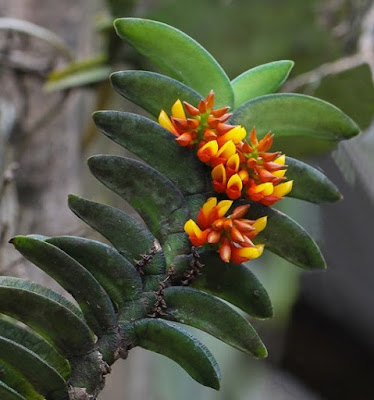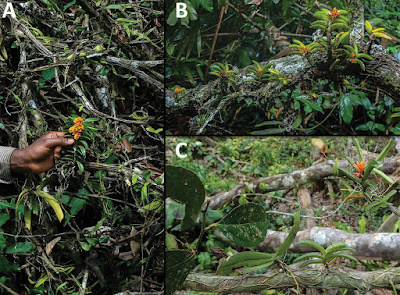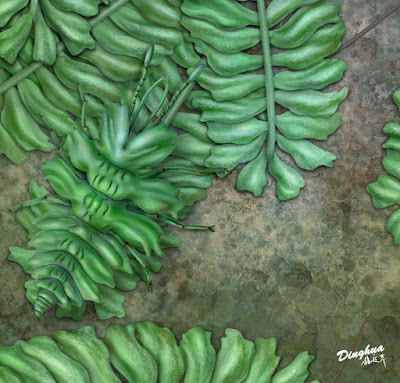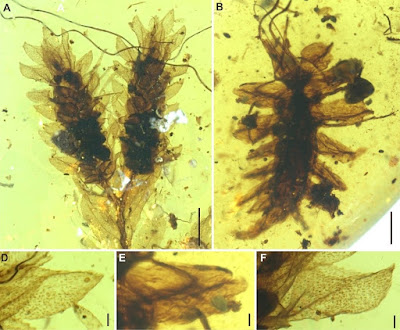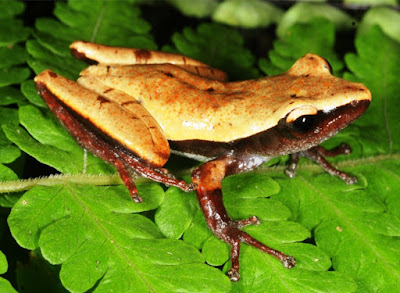[Most Recent Entries] [Calendar View]
Thursday, May 3rd, 2018
| Time | Event | ||||
| 10:03a | [Botany • 2018] Calyptrochilum aurantiacum • New Taxonomic and Conservation Status of Ossiculum (Vandeae, Orchidaceae), A Highly Threatened and Narrow-endemic Angraecoid Orchid from Central Africa
Abstract In the context of producing a revised phylogenetic Linnean taxonomy of angraecoid orchids, the monotypic and narrow-endemic genus Ossiculum is synonymised with Calyptrochilum. Accordingly, a new combination in Calyptrochilum is proposed for Ossiculum aurantiacum. The morphological and DNA-based evidence for this transfer is discussed. Moreover, Calyptrochilum aurantiacum is here firstly reported outside Cameroon, with a record from the Republic of the Congo. The Red List conservation status of this species is reassessed and it is to be downgraded from “Critically Endangered” (CR) to “Endangered” (EN), following the recent discovery of additional subpopulations in Cameroon. Keywords: Angraecoid orchids, Calyptrochilum, ex situ conservation, IUCN Red List Categories and Criteria, Mungo River Forest Reserve, Odzala National Park, Ossiculum aurantiacum Calyptrochilum aurantiacum (P.J.Cribb & Laan) Stévart, M.Simo & Droissart, comb. nov. Basionym: Ossiculum aurantiacum van der Laan & Cribb, 1986: 824. Conclusion: Morphological and DNA-based evidence led to the transfer of the narrow-endemic Ossiculum aurantiacum to the widespread genus Calyptrochilum and, thus, recognises the monotypic genus Ossiculum as a junior synonym of Calyptrochilum. Thanks to recent intensive field trips and laboratory work on central African orchids, new localities of Calyptrochilum aurantiacum have been discovered, a situation that contributed to downgrade the IUCN conservation status of the species. Calyptrochilum aurantiacum is currently known from five locations in two countries (Cameroon and Republic of the Congo) and is assessed as Endangered [EN B2ab(iii,v)] according to the IUCN Red List Categories and Criteria. Fieldwork within and around the Odzala National Park is required to evaluate the species habitat and the state of the subpopulation there. In situ studies on reproductive biology would be necessary for greater efficiency in conservation measures. Murielle Simo-Droissart, Tariq Stévart, Bonaventure Sonké, Sandrine Mayogo, Narcisse Kamdem and Vincent Droissart. 2018. New Taxonomic and Conservation Status of Ossiculum (Vandeae, Orchidaceae), A Highly Threatened and Narrow-endemic Angraecoid Orchid from Central Africa. PhytoKeys. 98: 85-97. DOI: 10.3897/phytokeys.98.23511 Résumé: En vue de produire une classification taxonomique linnéenne des orchidées angraecoïdes, le genre monotypique Ossiculum, longtemps considéré comme endémique du sud-ouest Cameroun, est placé en synonymie de Calyptrochilum. En conséquence, une nouvelle combinaison dans Calyptrochilum est proposée pour Ossiculum aurantiacum. Les données morphologiques et moléculaires qui justifient cette combinaison sont discutées. L’espèce est signalée pour la première fois hors du Cameroun, en République du Congo. Suite à la découverte récente de sous-populations supplémentaires au Cameroun, le statut de conservation de cette espèce est réévalué selon la liste rouge de l'UICN. Bien que toujours menacée, l’espèce Calyptrochilum aurantiacum est transférée de la catégorie “En danger critique” (CR) vers la catégorie “En danger” (EN). | ||||
| 2:02p | [PaleoEntomology • 2018] Phyllochrysa huangi • Liverwort Mimesis in a Cretaceous Lacewing Larva
Highlights • A new lacewing species is described from the Cretaceous based on larvae • Distinctive foliate lobes are present on the thorax and abdomen of these larvae • Such morphological modifications grossly match coeval liverworts • The new larvae are the first example of direct mimicry in lacewing larvae Summary Camouflage and mimicry are staples among predator-prey interactions, and evolutionary novelties in behavior, anatomy, and physiology that permit such mimesis are rife throughout the biological world. These specializations allow for prey to better evade capture or permit predators to more easily approach their prey, or in some cases, the mimesis can serve both purposes. Despite the importance of mimesis and camouflage in predator-avoidance or hunting strategies, the long-term history of these traits is often obscured by an insufficient fossil record. Here, we report the discovery of Upper Cretaceous (approximately 100 million years old) green lacewing larvae (Chrysopoidea), preserved in amber from northern Myanmar, anatomically modified to mimic coeval liverworts. Chrysopidae are a diverse lineage of lacewings whose larvae usually camouflage themselves with a uniquely constructed packet of exogenous debris, conveying greater stealth upon them as they hunt prey such as aphids as well as evade their own predators. However, no lacewing larvae today mimic their surroundings. While the anatomy of Phyllochrysa huangi gen. et sp. nov. allowed it to avoid detection, the lack of setae or other anatomical elements for entangling debris as camouflage means its sole defense was its mimicry, and it could have been a stealthy hunter like living and other fossil Chrysopoidea or been an ambush predator aided by its disguise. The present fossils demonstrate a hitherto unknown life-history strategy among these “wolf in sheep’s clothing” predators, one that apparently evolved from a camouflaging ancestor but did not persist within the lineage. Keywords: Neuroptera, Chrysopidae, Mesozoic, Burmese amber, mimicry, liverwort Systematic Paleontology Order Neuroptera Linnaeus, 1758. Superfamily Chrysopoidea Schneider, 1851. Phyllochrysa huangi gen. et sp. nov. Etymology The genus-group name is a combination of phyllon (Greek, meaning, ‘‘leaf’’) and chrysos (Greek, meaning, ‘‘gold’’ and a common suffix for chrysopoid genera). The specific epithet honors Yiren Huang, who kindly donated the holotype for our study. ....
Xingyue Liu, Gongle Shi, Fangyuan Xia, Xiumei Lu, BoWang and Michael S. Engel. 2018. Liverwort Mimesis in a Cretaceous Lacewing Larva. Current Biology. In Press. DOI: 10.1016/j.cub.2018.03.060 100-million-year-old liverwort mimicry in insects phys.org/news/2018-04-million-year-old-l | ||||
| 2:51p | [Herpetology • 2018] Theloderma auratum • A New Species of the Genus Theloderma Tschudi, 1838 (Anura: Rhacophoridae) from Tay Nguyen Plateau, central Vietnam
ABSTRACT A new species of small tree frog from a primary montane tropical forest of central Vietnam, Tay Nguyen Plateau, is described based on morphological, molecular, and acoustic evidence. The Golden Bug-Eyed Frog, Theloderma auratum sp. nov., is distinguishable from its congeners and other small rhacophorid species based on a combination of the following morphological attributes: (1) bony ridges on head absent; (2) smooth skin completely lacking calcified warts or asperities; (3) pointed elongated tapering snout; (4) vocal opening in males absent; (5) vomerine teeth absent; (6) males of small body size (SVL 21.8–26.4 mm); (7) head longer than wide; ED/SVL ratio 13%–15%; ESL/SVL ratio 16%–20%; (8) small tympanum (TD/EL ratio 50%–60%) with few tiny tubercles; (9) supratympanic fold absent; (10) ventral surfaces completely smooth; (11) webbing between fingers absent; (12) outer and inner metacarpal tubercles present, supernumerary metacarpal tubercle single, medial, oval in shape; (13) toes half-webbed: I 2–2¼ II 1½–2¾ III 2–3¼ IV 3–1½ V; (14) inner metatarsal tubercle present, oval; outer metatarsal tubercle absent; (15) iris bicolored; (16) dorsal surfaces golden-yellow with sparse golden-orange speckling or reticulations and few small dark-brown spots; (17) lateral sides of head and body with wide dark reddish-brown to black lateral stripes, clearly separated from lighter dorsal coloration by straight contrasting edge; (18) ventral surfaces of body, throat, and chest greyish-blue with indistinct brown confluent blotches; (19) upper eyelids with few (3–5) very small flat reddish superciliary tubercles; (20) limbs dorsally reddish-brown, ventrally brown with small bluish-white speckles. The new species is also distinct from all congeners in 12S rRNA to 16S rRNA mitochondrial DNA fragment sequences (uncorrected genetic distance P>8.9%). Advertisement call and tadpole morphology of the new species are described. Our molecular data showed Theloderma auratum sp. nov. to be a sister species of Th. palliatum from Langbian Plateau in southern Vietnam. Keywords: Theloderma auratum sp. nov.; mtDNA phylogeny; 12S rRNA; 16S rRNA; Kon Tum; Gia Lai; Endemism; Taxonomy
Theloderma auratum sp. nov. .... Etymology: The specific name “auratum” is a Latin adjective in the nominative singular (neutral gender), derived from Latin “aurum” for “gold”, referring to the golden-yellowish dorsal coloration of the new species. Recommended vernacular name: We recommend the following common name in English: Golden Bug-Eyed Frog. Recommended vernacular name in Vietnamese: ´Êch Cây Sân Vàng. Distribution and biogeography: The known distributions of Theloderma auratum sp. nov. and its sister species Th. palliatum are shown in Figure 1. To date, the new species is known from montane evergreen tropical forests of Tay Nguyen Plateau in the central Annamite (Truong Son) Mountains, and has been recorded in Gia Lai, Kon Tum, and Thua Thien-Hue provinces. It is anticipated that Theloderma auratum sp. nov. also occurs in the adjacent montane forests of Tay Nguyen Plateau; in particular, records from Quang Nam Province of Vietnam and Xekong Province of Laos are anticipated. Natural history notes: Our knowledge on the biology of Theloderma auratum sp. nov. is scarce. The new species was recorded in primary polydominant tropical montane evergreen forests of Tay Nguyen Plateau at elevations ranging from 800 to 1 400 m a.s.l.. Animals were recorded only in patches of primary undisturbed forest with complete multi-layered canopy and heavy undergrowth, suggesting the new species is a strict forest-dwelling specialist. At the type locality in Kon Chu Rang Nature Reserve (Gia Lai Province), the forest where the new species was recorded is dominated by large trees of the families Podocarpaceae (Dacrydium elatum, Dacrycarpus imbricatus), Magnoliaceae, Burseraceae (Canarium sp.), Myrtaceae (Syzygium sp.), Hamamelidaceae (Simingtonia sp.), Lauraceae (Litsia sp.), Rhodoliaceae (Rhodolia sp.), Fagaceae, Sterculiaceae (Scaphium sp.) (Figure 10). .... Nikolay A. Poyarkov, Jr., Ivan I. Kropachev, Svetlana S. Gogoleva and Nikolai L. Orlov. 2018. A New Species of the Genus Theloderma Tschudi, 1838 (Amphibia: Anura: Rhacophoridae) from Tay Nguyen Plateau, central Vietnam. Zoological Research. 39(3); 156-180. DOI: 10.24272/j.issn.2095-8137.2018.018 |
| << Previous Day |
2018/05/03 [Calendar] |
Next Day >> |
